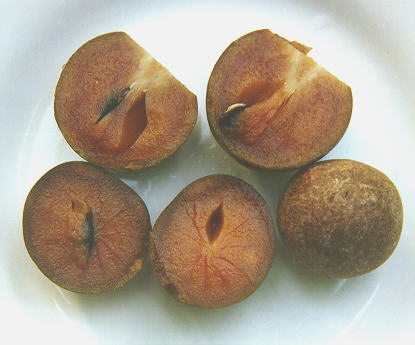The chemistry of naseberry
Introduction
Naseberry (Manilkara zapotilla, Sapotaceae) is native to Central and
South America. The tropical fruit tree may grow as tall as 30 m in Jamaica and it
is tolerant of dry conditions.
Chemistry
Sugars
The first report of the total soluble sugars for some varieties of naseberry
found between 20-25% [1] while the reducing and sucrose sugar content was
6.1-9.6% and 1.8-3.4% respectively.
A more recent study [2] on the glycemic index (GI) of fruits found
that naseberry had a rating of 57 which was attributed to the high dietary fibre
content 7.9%, fructose level of 5.3g and the presence of starch 0.8g per 100g portion.
Polyphenols
The fractionation [3] of a methanol extract from naseberry fruit resulted
in the isolation of two new antioxidants:
methyl 4-O-galloylchlorogenate
4-O-galloylchlorogenic acid,
both with high antioxidant properties, along with eight known polyphenolic antioxidants, namely:
methyl chlorogenate,
dihydromyricetin,
quercitrin,
myricitrin,
(+)-catechin,
(-)-epicatechin,
(+)-gallocatechin,
and gallic acid.
Pigments
Alkaloids
Volatiles
References
1). R.K. Jain and S.K. Jain,
Journal of Food Engineering 37 (1998) 323-330.
2). M.T.B. Guevarra and L.N. Panlasigui,
Asia Pacific J Clin Nutr (2000) 9(4), 303-308.
3).J. Ma, X-D. Luo, P. Protiva, H. Yang, C. Ma, M.J. Basile, I.B. Weinstein and E.J. Kennelly,
J. Nat. Prod. 2003, 66, 983-986.
Return to links to the chemistry of other Jamaican items, including
spices and fruit and vegetables.
 Return to Chemistry, UWI-Mona,
Home Page
Return to Chemistry, UWI-Mona,
Home Page
Copyright © 2005 by Robert John
Lancashire, all rights reserved.
Created and maintained by Prof. Robert J.
Lancashire,
The Department of Chemistry, University of the West Indies,
Mona Campus, Kingston 7, Jamaica.
Created January 2005. Links checked and/or last
modified 11th January 2005.
URL
http://wwwchem.uwimona.edu.jm/lectures/naseberry.html


 Return to Chemistry, UWI-Mona,
Home Page
Return to Chemistry, UWI-Mona,
Home Page